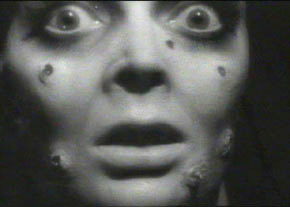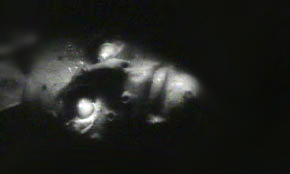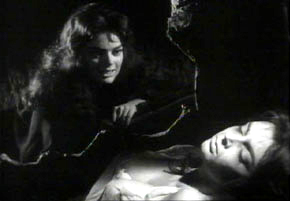
 |
|
|
|
Kino's new Blu-ray of Mario Bava's Black Sunday takes me back to the beginning of the DVD years, when we waited anxiously for every announcement that might herald a desired new genre favorite. While fans sitting on tons of suddenly worthless laserdiscs howled in protest, the ranks of new DVD owners swelled, encouraging every studio to churn out new product on a weekly basis. New companies sprang up to take advantage of the tastes of 'new adopters', a market heavily weighted in favor of young males that proved to have a deep interest in screen horror, the more bizarre the better. These importers brought forth bright new editions of movies known in America only on gray-market bootleg VHS tapes. Keen horror fans had already been primed to desire the Euro-horror depths of Argento, Fulci, et. al. through eight years of fascinating articles in Tim Lucas's Video Watchdog magazine. Image Entertainment's 1999 Black Sunday DVD delivered what fans wanted: a good transfer at the proper aspect ratio and quality extras befitting a prime piece of horror history. 1 
Last year Kino Lorber enlarged its Blu-ray purview by taking on the release of selected lines of classic horror product, including most of the output of the French horror specialist Jean Rollin. For this Halloween they're rolling out improved HD transfers of Mario Bava classics, starting with Black Sunday, Hatchet for the Honeymoon and Lisa and the Devil. The new releases come through an entity called International Media Films. Black Sunday hardly needs an introduction to the horror fan. The first real hit of the Italian horror wave that (with the rest of the world) followed the great success of England's Hammer Films, this creepy fairytale of witchcraft and vampirism introduced us to the immensely creative cameraman-director Mario Bava, a master of stylish and expressive camerawork previously specializing in effects work and exotic lighting for Italian fantasies and Riccardo Freda horror outings. Known in Italy as La maschera del demonio, the show also introduced the top horror heroine of the 1960s, English ex-model Barbara Steele. As had Louise Brooks before her, Steele turned her back on Hollywood and walked out of a 'big' job playing opposite Elvis Presley in Flaming Star, choosing instead to seek her fortunes in Rome. She eventually got her wish when Black Sunday led to a major role (with preferred billing) in Federico Fellini's 8½. Veteran writers Ennio de Concini and Mario Serandrei adapted the Gogol story as a fairy-tale nightmare of doppelgänger beauties, both played by Barbara Steele. A curse two centuries old revisits the Moldavian Vidar family when two travelers, Dr. Kruvayan (Andrea Checchi) and Dr. Gorobec (John Richardson) accidentally revive the corpse of the condemned witch Princess Asa (Steele). One doctor falls under Asa's spell and the other becomes enamored of Asa's lookalike descendant Katia. The rest of the tale is a dramatically forceful and visually riveting series of hauntings, possessions and murders as Asa seeks to possess the young body of Katia and fulfill her vow to destroy the House of Vajda. The dual performance of horror queen Barbara Steele launched a hundred Euro-horror films to follow. The perfect introduction to the world of Mario Bava, Black Sunday is a real shocker that took a different visual path than the work of Hammer. Its intense images evoke the B&W classics of previous decades while adding queasy textures and details of Bava's own devising. Impressive special lighting effects conjure up all manner of magic tricks: the Karl Struss red filter trick that causes old-age makeup to appear and disappear; foreground mattes and miniatures that extend and enhance settings; superimpositions that create unexpected jolts, like Javutich suddenly appearing in a darkened alcove. Bava uses slow motion to make a ghostly carriage glide through the moonlight on a satanic mission. 2 
Bava communicates directly through his visuals, giving his films a universal appeal. He uses his camera tricks to create moments more gruesome and macabre than any seen previously. The branding of Asa, the nailing of the spiked Mask of Satan (with an enormous mallet!) and a stake driven through an eye of an undead corpse are violent highlights. Audiences had never seen images as creepy as the sight of insects and scorpions crawling about Asa's disfigured face. When the witch revives, eyes well up in her eye sockets like slimy eggs. The Raymond Durgnat quote up top is still the best distillation of the perverse appeal of horror icon Barbara Steele. She combines sexuality with a kind of unearthly hunger that connects immediately with the concept of 'unwholesome lust.' Steele's drawn features and haunted eyes express more than did previous raven-haired vamps from the Charles Addams mold, like Carroll Borland: something unknowable, feral. Bava found other actresses to play his tortured heroines -- Dahlia Lavi comes to mind. But in Black Sunday Bava and Steele created a new and exciting sensation in screen horror. Kino Classics' Blu-ray of Black Sunday is the expected improvement, with a sharper HD image that benefits from a wider range of contrast. The all-important textures in Bava's cinematography are given a big boost. The delicate shafts of light that herald the phantom coach seem even more ghostly., and we can now perceive details like the slime on Javutich's clawed fingers as he rises from the grave. Enhanced close-ups allow us to see the rough texture of Asa's face being rejuvenated as she saps the life force from her victim Katia. As has been explained in many reviews, most U.S. viewers were once familiar with a different Black Sunday. A.I.P. importers James H. Nicholson and Samuel Arkoff apparently did not like the music and/or the dialogue on the export version prepared for them in Italy, The Mask of Satan. They redid the entire soundtrack. More active and varied music by Les Baxter replaced Roberto Nicolosi's rather lethargic music score. A.I.P. re-voiced the entire film as well, resulting in some vocal performances that seem forced. I've personally seen the American cut of Black Sunday only once in a theater, where a number of dialogue lines elicited laughs. 
The A.I.P. cut with the Les Baxter music track has never been released on DVD, and appears only on a cropped, slightly squeezed older Image laserdisc from about 1989. As that version belongs to MGM, which no longer has rights to the film, the Baxter score is locked up in rights issues. 3 What has been seen and heard on all DVD presentations is the Italian-prepared English language export version entitled The Mask of Satan, which retains the original Nicolosi score along with several uncensored moments later removed by A.I.P. including an entire short dialogue scene between Katia and John Richardson. This export version was banned in England for eight years. The key extra remains Tim Lucas's original feature commentary, one of the first notable horror film commentaries produced for DVD and a model for commentary tracks to come. Lucas shows his command of the subject matter, and even proposes a radical theory that Black Sunday was reworked in post editorial (a Savant fascination): some of Barbara's scenes as the virginal Katia may have been originally shot to suggest that 'Katia' was being impersonated by the evil witch Asa. Kino also includes English and American trailers for the movie, and an American TV spot that uses a single artwork image of Steele's face. It's obvious that A.I.P. was enthusiastic about Barbara Steele and Mario Bava. She was signed almost immediately to play opposite Vincent Price in Roger Corman's Pit and the Pendulum. Bava would soon be working on Italian-A.I.P. co-productions like Black Sabbath and Planet of the Vampires.
On a scale of Excellent, Good, Fair, and Poor,
Black Sunday Blu-ray rates:
Footnotes:
1. Black Sunday was also one of the first DVDs reviewed by the newly-coined 'DVD Savant' for Steve Tannehill of the old DVD Resource site. Savant wrote another article about cuts made to Black Sunday when it was imported to England and America, Censorship for a Celebrated Horror FIlm: Black Sunday.
2. Bava also uses slow-motion trickery when John Richardson's hero crashes into the Vajda house, to make the stunt jump appear to be from a greater height. Using a slow-motion upward angle to extend a jump had been very effective in H.G. Clouzot's The Wages of Fear.
3. Just the same, we can hope: it would be great to hear the Les Baxter music score again. I'm also told that the audio mix on the original Italian-language La maschera del demonio is superior to either English language version. 4. From correspondent Tim Rogerson, 9.19.12: Glenn -- Enjoyed your review but just a couple of points on the UK censorship front. This export version was banned in England for eight years. Actually it was the AIP version which was banned as your linked article on the censorship history makes clear (and the BBFC website records the film by its AIP title. The distributors, Anglo Amalgamated were, in substance, AIP's distributors in the UK until Deke Heyward set up shop in 1967). What is not clear to me is whether it was the uncensored or the MPAA censored version that was banned. Your linked article implies that it was probably the former. At the time of the rejection (Jan/Feb 1961) BBFC secretary John Trevelyan was under a lot of pressure over the content of horror films and X films in general and was taking no chances. Around the same time, The Brain That Wouldn't Die was rejected and Hammer's Curse of the Werewolf cut by about 5m. By rejecting and heavily cutting horror films Trevelyan was seeking to protect the 'arty' X films like Room at the Top and Saturday Night and Sunday Morning. Black Sunday was finally certified after cuts in 1968 under the title Revenge of the Vampire. These are the cuts per the BBFC's 1968 Cuts Register: REVENGE OF THE VAMPIRE : Classified 'X' in 1968 after the following cuts:
R1 - Remove shot of branding iron being pressed on woman's back. I saw this print at the cinema and various other shots were missing too (eg the spurt of blood after the mallet bashing) so I suspect that this version must have been pre-cut (maybe it was the cut AIP version). In England no certificate meant no release, period. The only places Black Sunday could have screened in Great Britain would have been private clubs and perhaps museums, in the unlikely chance that contemporary horror films were being celebrated at the time. In the UK cinema censorship rests with the local authorities (local councils) and still does. In substance, the BBFC acts as their agent but in the event of a rejection by the BBFC the distributor could always take the film to a local authority and ask for a certificate. This used to be not uncommon in the 1960s but I'm guessing Anglo thought it not worthwhile with Black Sunday given the cost of trying to take it to several hundred authorities individually versus the likely level of acceptances and box-office receipts. Of course, things also worked the other way round - Peeping Tom for example, which had a BBFC X certificate, was banned by at least two local authorities. Regards, Tim Rogerson
Reviews on the Savant main site have additional credits information and are often updated and annotated with reader input and graphics. Also, don't forget the 2011 Savant Wish List. T'was Ever Thus.
Review Staff | About DVD Talk | Newsletter Subscribe | Join DVD Talk Forum |
| ||||||||||||||||||